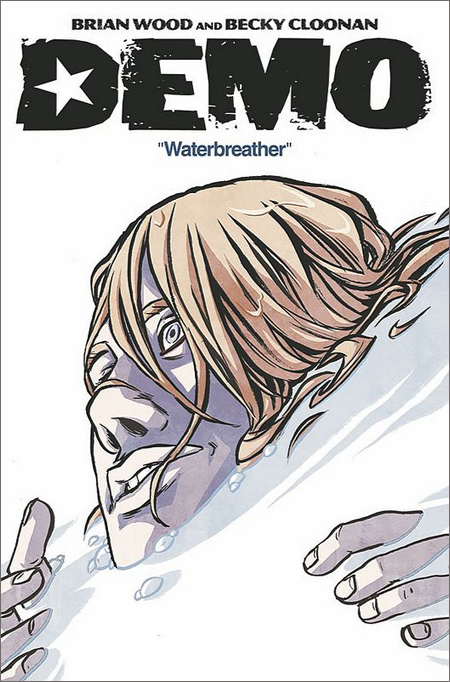#May2010
Images & Words – “Waterbreather”
[images & words is the comic book pick-of-the-week at OL. equal parts review and diatribe, the post highlights the most memorable/infuriating/entertaining book released that wednesday]
Spoilers Ahead. Forreal.
I truly, genuinely and eagerly love comic books. Not just the tales of heroism and superpowered romps against villainy, but the medium itself. I find it inspiring that such a simple means of communication can convey fantastic ideas. Take some pictures, add some text if you feel up to it, stir it around in a bubbling creativity-churn and then you end up with whatever it was your brain was trying to squeeze out.
With nothing more than images and words an individual can do anything.
And this is exactly how I felt as I read the “Waterbreather” — the fourth issue of DEMO.
But let’s step back for a second. What exactly is DEMO? Well, originally it was an independently released twelve-issue miniseries by writer Brian Wood and artist Becky Cloonan. Each of these issues is a self-contained story, sometimes focusing on the supernatural but always highlighting the personal lives of young people. The series was a success, garnering a ton of critical acclaim (and therefore, commercial options) for both creators.
Six years later, DEMO has returned for its second volume; this time around, it’s a six-issue miniseries put out by Vertigo. Despite being published by a major imprint, the premise is essentially the same — each issue is a quirky, character-driven tale and is accompanied by notes, sketches, and commentaries by both Wood and Cloonan. It’s a sick format through and through, as the reader is treated to not only a great story but also some insight into what the creative mindsets were as it was being crafted. Maybe it’s the aspiring writer in me, but I love to read about what music creators were listening to or what personal trials they were dealing with while trying to maintain imaginative productivity.
This is only the second comic (the first being Doktor Sleepless) I have read in which the “Backmatter” is less about promoting the next issue and more about giving an authentic behind the scenes feature. As a result, the very structure of DEMO qualifies it as a praiseworthy book.
Luckily, DEMO also presents incredibly strong stories which use unique circumstances as vehicles for presenting relatable sentiments. “Waterbreather” tells the story of Colin, a down-on-his-luck preteen who has the misfortune of spending a summer vacation at a ramshackle campground. Terrorized by a pack of redneck/townie bullies, Colin is eventually beaten up and tossed into the lake. However, minutes go by and the victim never surfaces, which of course causes the bullies to freak out with the thought that they are now murderers.
What they don’t know is that Colin (as he is just learning himself) can breathe underwater. In fact, after finally resurfacing the youth feels as though inhaling air is now lackluster. He narrates,
And breathing air again felt thin and insubstantial. Like wasn’t getting…enough.
That feeling would stick with me.
The reader spends the remainder of “Waterbreather” with Colin as he explores the possibilities provided by his newfound skill. In the process, some weighty questions are dealt with. What happens when an individual uses an inherent ability for personal gain? Does being above average make it difficult to live amongst the humdrum? Is hindsight always 20/20 or will we always be presented with questions that have no answers?
And as well-crafted of a script as Woods presents, it really succeeds because of Cloonan’s dynamic art. At some points the artist fearlessly conquers every square inch of the page, filling in minute details wherever a blank space hopes to prevail. On the other hand, some of the most poignant panels of “Waterbreather” feature a single image that is bathed in a sea of negative space; this approach is especially effective as the artist limits herself to black-and-white.
Thinking on it now, I suppose the best phrase I can think of to describe Becky Cloonan’s visuals is applied appropriately. Every image that is laid onto the page has a proper place, as though it is a piece of a puzzle and nothing else would fit in that spot. Often, these puzzle-pieces are rather simple, allowing for the momentum of the plot to push the reader through the narrative. However, there are also many moments in which busy illustrations are necessary, such as a swirling underwater scene in which panic is the primary sensation. Every emotion is perfectly represented, and as a result the reader cannot help but become enthralled.
“Waterbreather” is a twenty-four page collection that introduces a character, makes us care about him, and then resolves his story. Clearly, Wood and Cloonan are a pair comfortable collaborating with one another, as both the story and its presentation are executed with a flourish of which dysfunctional couples are incapable. It is comics like this fourth issue of DEMO that should put on the pedestal, placed in plain view, and presented as evidence of the medium’s true value.
Because comics can help us do anything. Even breathe underwater.
[Suggested pairing: Thrice — Alchemy Index Volume II]





